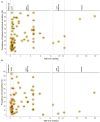Impaired Nutritional Condition After Stroke From the Hyperacute to the Chronic Phase: A Systematic Review and Meta-Analysis
- PMID: 35178021
- PMCID: PMC8846185
- DOI: 10.3389/fneur.2021.780080
Impaired Nutritional Condition After Stroke From the Hyperacute to the Chronic Phase: A Systematic Review and Meta-Analysis
Abstract
Background: Malnutrition is common after stroke and can affect rehabilitation and healthcare costs. A comprehensive overview of stroke patients' nutritional condition from the hyperacute to the chronic phase is lacking. This systematic review aimed to investigate the prevalence of impaired nutritional condition (INC) across the continuum of care in specific phases after stroke.
Methods: CAB ABSTRACTS, Embase, MEDLINE, were used to collect studies published between 01-01-1999 and 26-08-2020. Primary and secondary outcomes were prevalence of INC and prevalence of malnutrition, respectively. Exploratory outcomes were prevalence of INC at follow-up, nutritional examination methods, prevalence of dysphagia, stroke severity, adverse events, and continent-specific prevalence of INC. A random-effects meta-analysis model was used to estimate the phase-specific pooled prevalence of INC and malnutrition.
Results: The dataset consisted of 78 study groups selected over a total of 1,244 identified records. The pooled prevalence of INC and malnutrition were 19% (95%CI:7-31) (N = 4) and 19% (95%CI:9-29) (N = 3), 34% (95%CI:25-43) (N = 34) and 26% (95%CI:18-35) (N = 29), 52% (95%CI:43-61) (N = 34) and 37% (95%CI:28-45) (N = 31), 21% (95%CI:12-31) (N = 3) and 11% (95%CI:0-24) (N = 3) and 72% (95%CI:41-100) (N = 3) and 30% (95%CI:0-76) (N = 2) in the hyperacute, acute, early subacute, late subacute, and chronic phase, respectively.
Conclusion: INC and malnutrition are highly prevalent in all stages of stroke care. Since malnutrition has been shown to negatively affect clinical outcomes, mortality, and overall healthcare expenditure in stroke survivors, it is essential to examine and monitor the nutritional status of stroke patients throughout their care journey to guide and plan, timely nutritional support and dietary modification.
Keywords: malnutrition; neurorehabilitation; nutritional status; stroke; stroke recovery; stroke rehabilitation.
Copyright © 2022 Huppertz, Guida, Holdoway, Strilciuc, Baijens, Schols, van Helvoort, Lansink and Muresanu.
Conflict of interest statement
SG, ML, and AHe are employees of Danone Nutricia Research. JS and AHo have been consultants for Danone Nutricia Research. VH and JS received financial support for their research. LB is a consultant for Phagenesis Limited, Manchester, United Kingdom. The authors declare that this study received funding from Danone Nutricia Research. The authors employed by the funder had co-involvement in the following parts of the study: design, data collection, analysis, interpretation of data, the writing of this article and the decision to submit it for publication.
Figures







References
-
- IntercollegiateStroke, ICSWP. Bowen A, James M, Young G. National clinical guideline for stroke. In: Royal College of Physicians; (2016).
-
- Winstein CJ, Stein J, Arena R, Bates B, Cherney LR, Cramer SC, et al. . Guidelines for adult stroke rehabilitation and recovery: a guideline for healthcare professionals from the American Heart Association/American Stroke Association. Stroke. (2016) 47:e98–e169. 10.1161/STR.0000000000000098 - DOI - PubMed
Publication types
LinkOut - more resources
Full Text Sources

